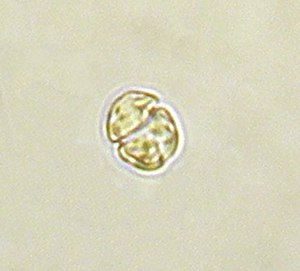Gymnodinium
| Gymnodinium | ||||||||||||
|---|---|---|---|---|---|---|---|---|---|---|---|---|

Gymnodinium sp. |
||||||||||||
| Systematics | ||||||||||||
|
||||||||||||
| Scientific name | ||||||||||||
| Gymnodinium | ||||||||||||
| F. Stein |
Gymnodinium is a genus of dinoflagellates with around 250 species that occur in fresh and marine water .
features
The representatives are unicellular. They have a longitudinal furrow (sulcus) and a belt-like pronounced transverse furrow (cingulum). A scourge arises in the longitudinal furrow, it is long and extends beyond the end of the cell. The second flagella lies in the transverse furrow and allows the unicellular organism to rotate around its longitudinal axis and feed it. The transverse furrow divides the cell into two equally sized halves. The genus lacks the richly ornamented cellulose plates under the cell surface, which are characteristic of other dinoflagellates. Here one speaks of athecatic dinoflagellates. In outline, the cell is approximately oval or spherical. Inside the cell there is a large nucleus and a number of small and mostly brown plastids. The plastids can also be colorless or of a different color, depending on the species. Some species have an eye spot .
The cells are 9 to 120 micrometers long. The species differ in the cell size, the size ratio of the two cell halves, the length of the longitudinal furrow, the shape and flattening of the cells and the presence, distribution and color of the plastids.
Asexual reproduction occurs through division into two parts, through the formation of zoospores or through the formation of daughter cells without furrows and flagella. Sexual reproduction takes place through the fusion of two genetically different but morphologically identical sex cells ( isogamy ). The permanent zygote thus formed germinates later with reduction division .
Some species of Gymnodinium form chain-like colonies, such as B. the species G. impudicum . G. catenatum , a highly poisonous species, is one of the chain-like species .
Occurrence
Gymnodinium occurs in all waters. Of the more than 200 species, around 30 are found in freshwater. You can eat a mixotroph . Often there are mass occurrences in spring.
Individual evidence
- ↑ Robert Hofrichter (ed.), The Mediterranean II / 1, 2003, ISBN 3827410908
literature
- Karl-Heinz Linne von Berg, Michael Melkonian u. a .: The Kosmos algae guide. The most important freshwater algae under the microscope. Kosmos, Stuttgart 2004, ISBN 3-440-09719-6 , p. 92.